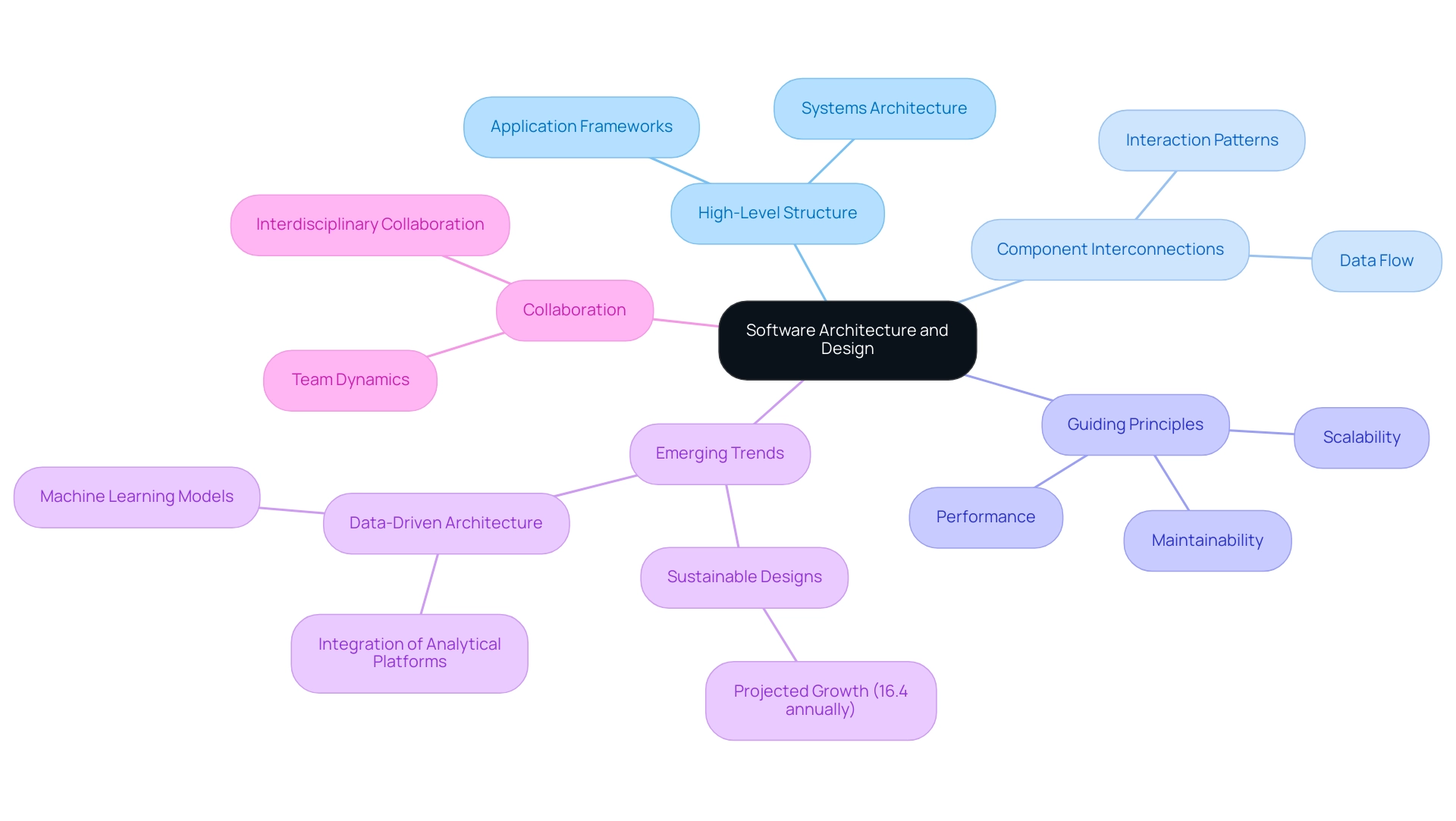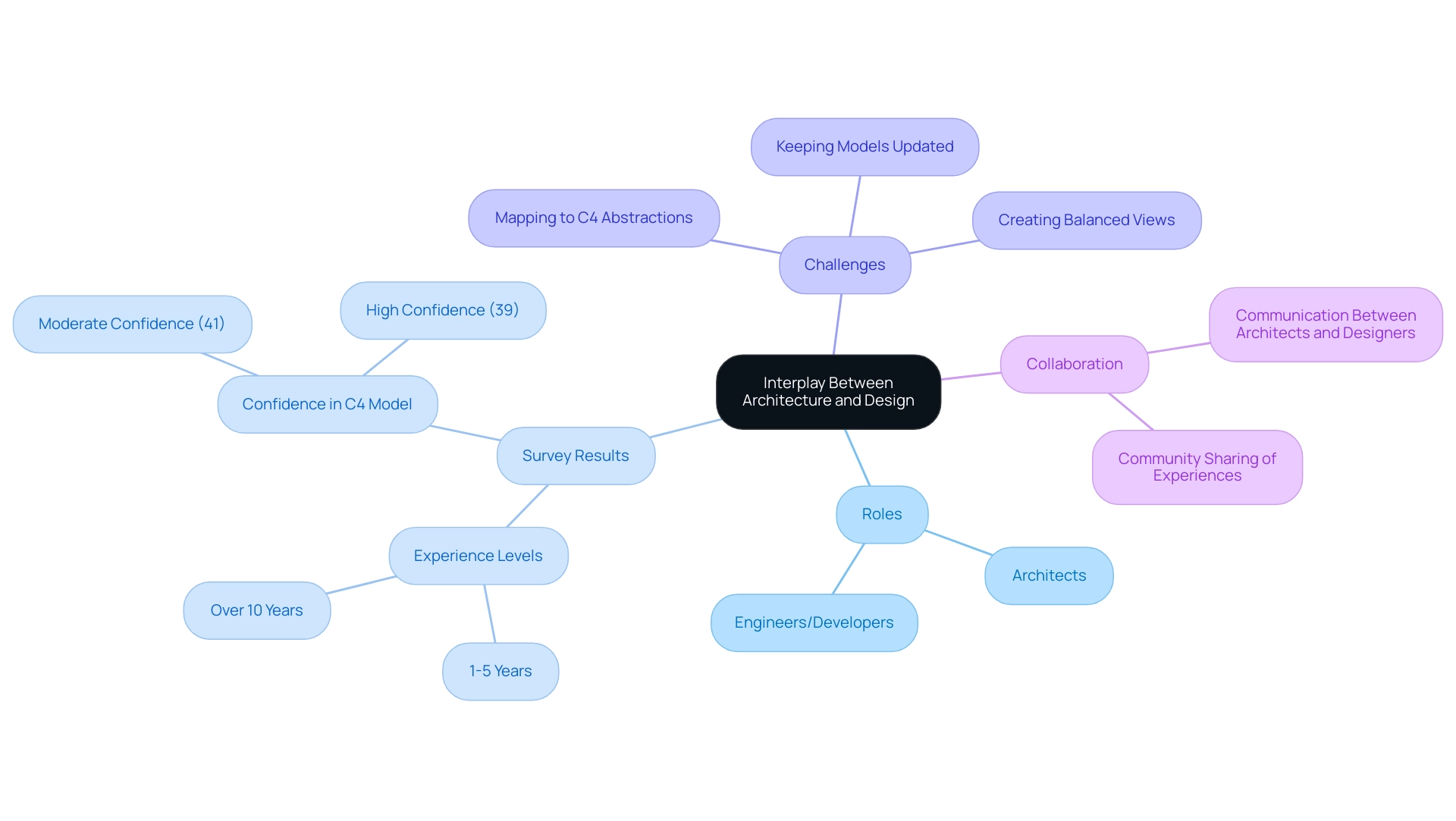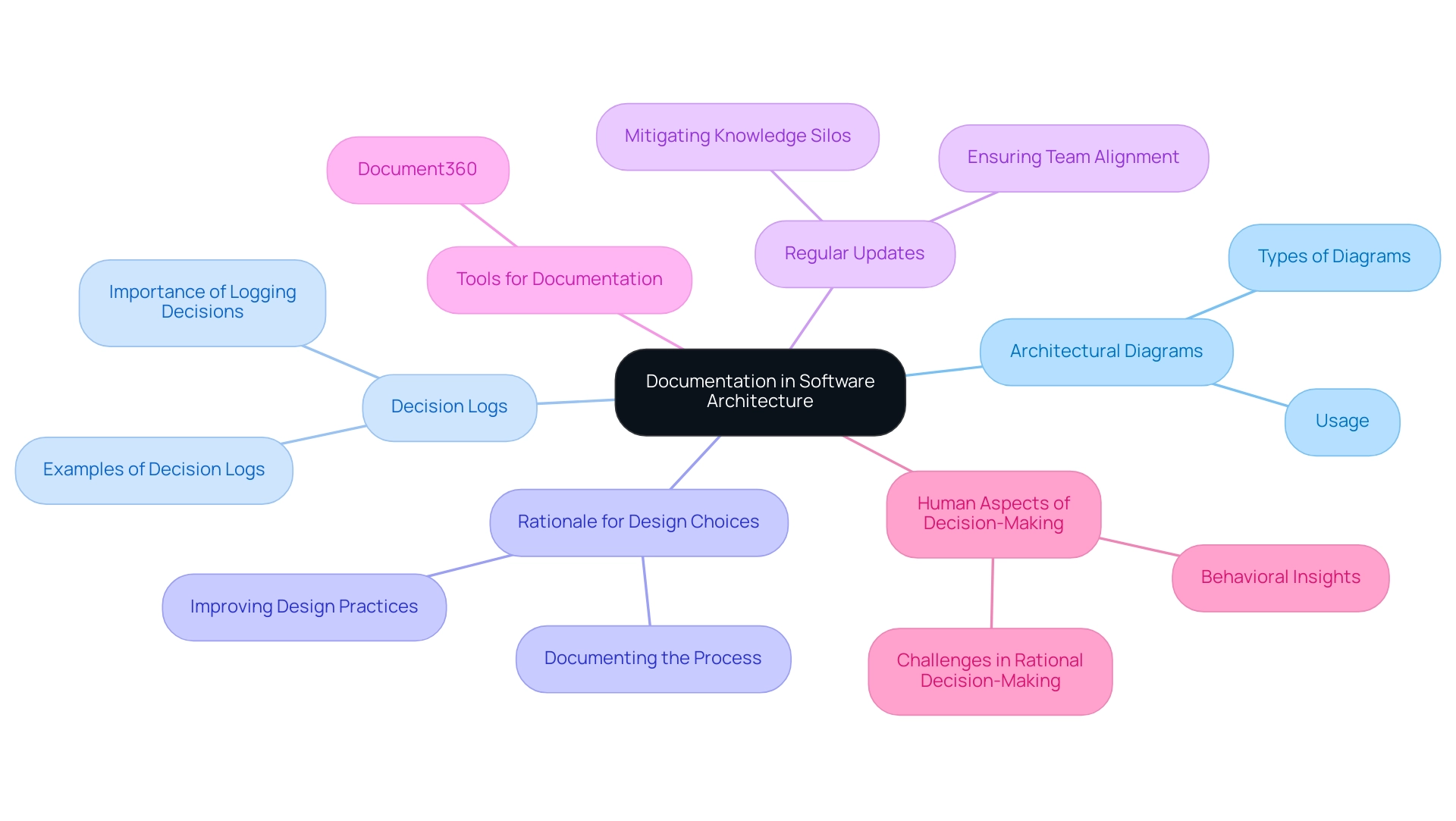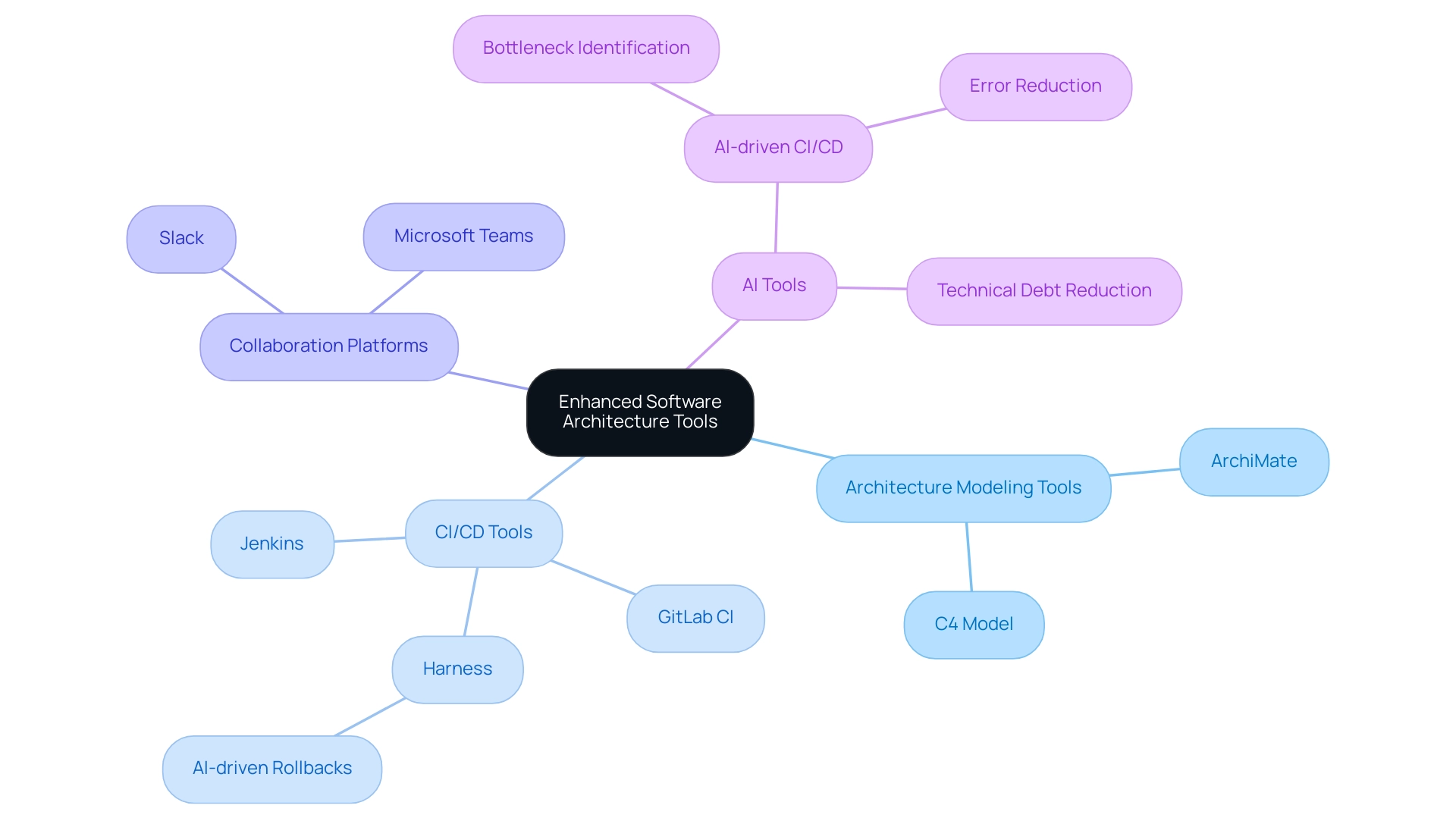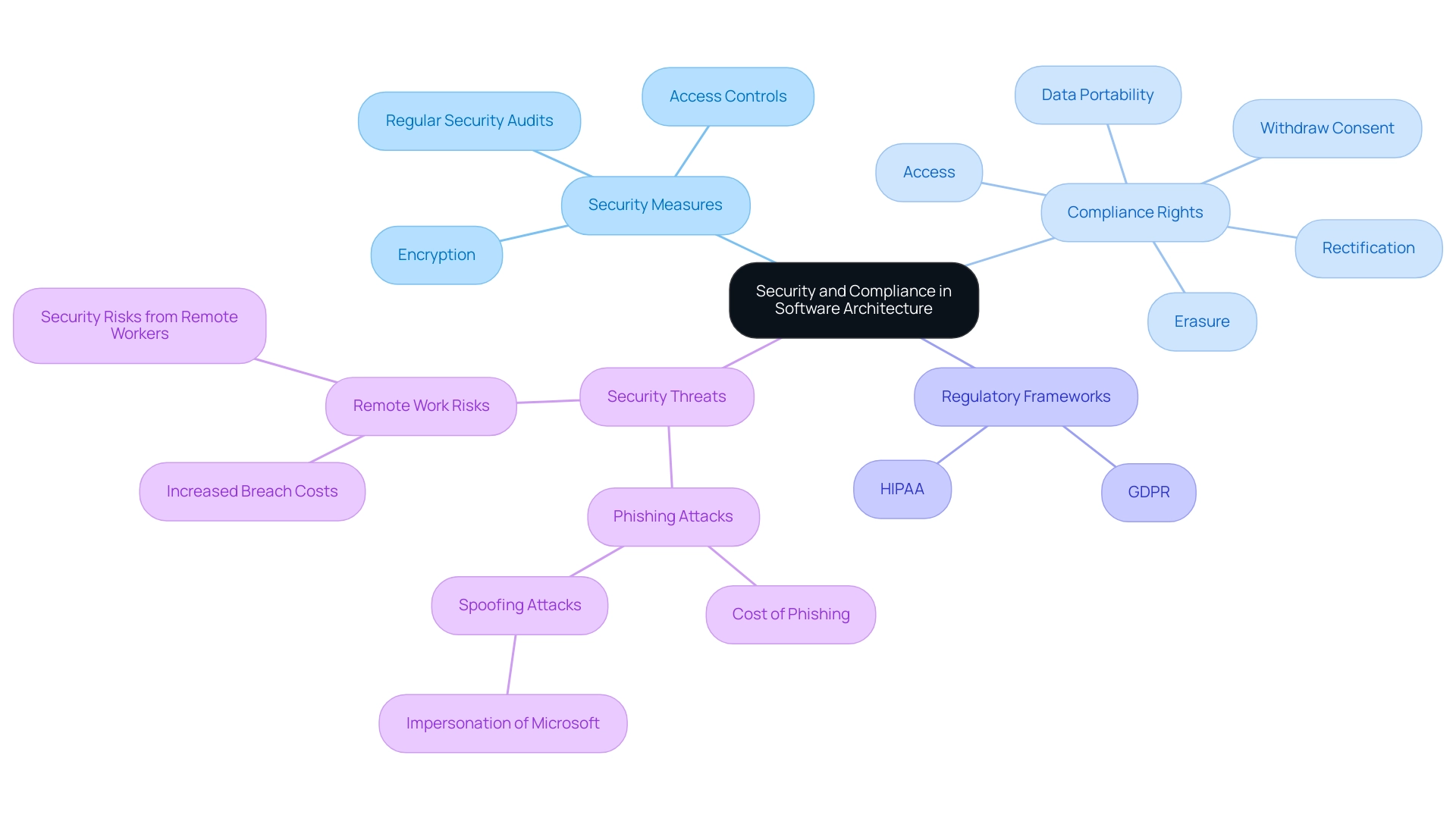Overview
The article focuses on best practices for architecture and design in software, emphasizing the importance of modularity, scalability, and integration of AI tools to enhance system performance and adaptability. It supports this by discussing how effective architectural strategies can mitigate technical debt, improve collaboration among teams, and ensure compliance with security regulations, ultimately leading to more robust and sustainable software solutions.
Introduction
In the rapidly evolving landscape of software development, the interplay between architecture and design forms the backbone of successful systems. As organizations strive to meet growing demands and adapt to technological advancements, understanding the nuances of software architecture becomes imperative.
This article delves into the foundational concepts of software architecture and design, exploring their critical roles in:
- Scalability
- Maintainability
- Performance
With insights into emerging trends, the importance of documentation, and the integration of AI tools, readers will discover how effective architectural practices can drive innovation and ensure compliance in an increasingly complex environment.
The journey through these interconnected principles highlights the necessity for collaboration and continuous improvement, ultimately shaping the future of software solutions.
Understanding Software Architecture and Design
Architecture and design in software serve as the essential framework of an application, outlining its high-level structure, components, their interconnections, and the guiding principles for development and evolution. In contrast, the architecture and design in software delves into the intricate details of implementation, determining how individual components interact and operate. A thorough understanding of architecture and design in software concepts is essential, as they significantly influence a system’s ability to scale, maintain, and perform effectively.
For instance, systems architected with foresight can adeptly handle rising user demands, while inadequately designed systems may falter under pressure, leading to performance bottlenecks and user dissatisfaction.
Leveraging AI tools can help identify and mitigate technical debt; for example, implementing AI-driven code analysis tools can highlight areas of inefficiency and suggest refactoring opportunities. By sharing experiences and solutions within our teams, we can address common challenges in team dynamics, fostering collaborative solutions that lead to efficient software development. This collaborative method emphasizes the significance of strong system design in attaining optimal metrics.
Core Principles of Effective Software Architecture
The foundation of effective architecture and design in software is based on several core principles: modularity, scalability, and separation of concerns. Modularity facilitates the creation of independent components that can be tested and deployed separately, significantly enhancing maintainability. Recent trends indicate that in 2024, 50% of organizations acknowledge modularity as vital for their structure, emphasizing its role in streamlining development processes.
Furthermore, with 50% of architects believing they will have more responsibility for security and compliance, the emphasis on architecture and design in software becomes even more pronounced, ensuring systems can expand to meet growing demands without necessitating extensive rework. As technology advances, the necessity for flexible structures has become clear; indeed, many software architects indicate a willingness to embrace new digital tools that improve scalability, such as AWS AI/ML services that provide pay-as-you-go options for customized solutions.
When choosing the appropriate AI technology, businesses should adopt a gradual approach:
- First, pinpoint the specific needs and challenges;
- Next, assess whether a rule-based chatbot, an AI-driven virtual assistant, or a hybrid model best meets those needs.
For instance, rule-based chatbots are ideal for handling frequently asked questions, while AI-driven virtual assistants can manage more complex interactions. Hybrid models can be employed in the architecture and design in software when human intervention is necessary, blending efficiency with empathy. The principle of separation of concerns in architecture and design in software advocates for dividing a system into distinct features, thereby minimizing interdependencies and simplifying management.
This approach is increasingly relevant in a landscape where 65% of architecture students foresee technology radically changing the industry. Factors such as community-driven insights and the sharing of experiences in bespoke software and consulting are critical in navigating these changes. A relevant case study illustrates this trend: with a growing emphasis on sustainability, 80% of AEC professionals prioritize sustainable design, and 57% of architects expect to use AI for environmental sustainability analysis in the next two years.
The demand for sustainable and scalable software architecture is projected to grow significantly, with an annual growth rate of 16.4% through 2027. By adhering to these principles and strategically selecting AI technologies (be it rule-based chatbots, AI-driven virtual assistants, or hybrid models) organizations not only streamline their development efforts but also foster the creation of resilient and adaptable technological solutions. For example, implementing a modular approach can allow for easier updates and integration of new AI technologies as they become available.
As noted by Tom Soldan from the Institute of Data, ‘This ongoing support ensures you gain long-term benefits from your education, giving you the tools and connections needed for success.’ This insight emphasizes the significance of creating software systems that are not only efficient today but also viable for the future.
The Interplay Between Architecture and Design
The connection between software structure and planning is essentially interdependent, marked by a repetitive and gradual development process. Efficient structures create a solid framework that directs planning choices, enabling the development of unified systems. For example, when implementing a microservices framework, architects offer the structure that allows groups to autonomously create, develop, and deploy separate services.
This synergy not only drives innovation but also ensures that each component aligns with overarching business objectives. Regular communication between architects and designers is crucial for maintaining this equilibrium; it fosters a collaborative environment where system requirements and constraints are clearly understood. In this context, sharing experiences within the community can validate ideas and uncover solutions to common challenges in group dynamics.
A recent survey revealed that the majority of respondents were full-time professionals, with 55% serving as architects and 26% as engineers or developers. Notably, 38% of these individuals had 1-5 years of experience, while 41% had over a decade in the field, highlighting the varying levels of expertise that can influence collaborative dynamics. Furthermore, a systematic literature review identified 742 citations, emphasizing the depth of research surrounding this relationship.
As Melvin Conway aptly stated,
Any system of consequence is structured from smaller subsystems that are interconnected.
The Role of Documentation in Software Architecture
Documentation is a crucial foundation of system architecture, acting as a thorough reference for planning choices, system elements, and their interactions. High-quality documentation should encompass:
- Architectural diagrams
- Decision logs
- The rationale behind design choices
Providing clarity for all members, including new hires. Proper documentation prevents chaos and confusion within software groups, ensuring that everyone is aligned and informed.
Regular updates to documentation are crucial as systems evolve, mitigating the risks of knowledge silos and miscommunication within teams. In 2024, leveraging platforms like Document360 can significantly enhance the management and accessibility of architectural documentation, fostering collaboration and ensuring that valuable insights are readily available. A literature review titled “Human Aspects in Software Architecture Decision Making” highlights how architects make decisions in real-world settings, challenging the assumption that decision-making is purely rational.
This underscores the importance of documenting the decision-making process to improve architectural design practices. As mentioned by Selvaraaju Murugesan,
Writing is a fundamental skill that technical writers possess strong expertise in
emphasizing the need for proficient documentation in system design. By adhering to these best practices, groups can create a robust framework in architecture and design in software that supports scalability and adaptability as organizations grow.
Leveraging Tools for Enhanced Software Architecture
The effective utilization of the right tools is crucial for enhancing architecture and design in software systems. Architecture modeling tools such as ArchiMate and the C4 Model are essential in the field of architecture and design in software, as they help visualize complex systems and their interactions, thereby simplifying the communication of ideas across diverse teams. As one engineer aptly noted,
These tools provide clarity and foster collaboration, which is essential in today’s fast-paced development environment.
However, challenges persist, particularly with the C4 model, where difficulties arise in mapping elements to C4 abstractions and keeping models updated to reflect real-world changes. For instance, one community member remarked, ‘I often struggle to align our current structure with the C4 model, which leads to confusion in our team.’
Results from a recent study on the C4 model indicated that 41% of participants showed moderate confidence in utilizing the model, while 39% noted high confidence, highlighting the necessity for continued discussion to navigate these complexities and the significance of customized consulting solutions in system design, AI integration, and cloud optimization.
Furthermore, Continuous Integration and Continuous Deployment (CI/CD) tools like Jenkins and GitLab CI significantly enhance deployment efficiency by streamlining the process, allowing for rapid iterations and invaluable feedback loops. With the integration of AI-driven CI/CD tools, organizations can automate repetitive tasks, minimize human intervention, and reduce deployment errors by 60%, as indicated by a report from Puppet Labs. For instance, Harness leverages machine learning to automate rollbacks in case of deployment failures, thereby enhancing overall efficiency.
AI also plays a critical role in identifying bottlenecks within CI/CD pipelines, ensuring smoother operations and faster delivery. Recent statistics indicate that the adoption of CI/CD tools has led to a measurable improvement in software development cycles, underscoring their importance in modern engineering practices. Notably, in AY 2022-2023, 30,068 students were enrolled in NAAB-accredited programs, emphasizing the growing importance of education in the field.
Additionally, collaboration platforms such as Slack and Microsoft Teams ensure that team members remain aligned on their architecture and design in software goals and decisions. The architecture and design in software sector is also undergoing considerable transformations, with cities such as Atlanta, GA, demonstrating a strong demand for architects, which further contextualizes the necessity for effective architectural design in response to these trends. By leveraging these advanced tools, including AI capabilities, organizations can cultivate a culture of continuous improvement and collaboration, ultimately leading to more robust and scalable solutions.
Furthermore, the incorporation of AI tools not only streamlines processes but also aids in reducing technical debt, enabling teams to concentrate on delivering high-quality products efficiently.
Ensuring Security and Compliance in Software Architecture
Integrating security and compliance into system design necessitates a thorough grasp of relevant regulations, particularly GDPR for data protection and HIPAA for healthcare. As businesses increasingly adapt to remote work, the stakes are high; the average cost of a data breach has surged by $137,000, with 54% of IT professionals citing remote workers as a significant security risk. Alarmingly, 62% of businesses experienced phishing and social engineering attacks in 2018, highlighting the urgent need for effective security protocols.
To mitigate these concerns, implementing security measures such as:
- Encryption
- Access controls
- Regular security audits
is paramount. Furthermore, understanding your rights under GDPR—including:
- Access
- Rectification
- Erasure
- Data portability
- The right to withdraw consent
is essential for ensuring compliance.
Users also have the right to file a complaint with the competent supervisory authority regarding their personal data processing. For instance, adopting a zero-trust framework can effectively reduce vulnerabilities by ensuring that every access request is rigorously authenticated and authorized. Additionally, it’s worth noting that 43% of spoofing attacks impersonated Microsoft, emphasizing the types of security threats organizations face, particularly in the context of remote work.
Incorporating compliance checks into the Continuous Integration/Continuous Deployment (CI/CD) pipeline not only encourages adherence to regulatory standards, including GDPR, but also streamlines these processes throughout the development lifecycle. With $17,700 lost every minute due to phishing attacks, the integration of robust security frameworks is not just a necessity but a critical business imperative in today’s landscape.
Navigating Challenges in Software Architecture and Design
Navigating the complexities of architecture and design in software requires a keen focus on several challenges, particularly the delicate balance between managing technical debt and fostering innovation. Tailored technical strategies, including custom technology solutions designed for specific needs and goals, are essential for achieving scalable and sustainable growth in bespoke software development. Ensuring alignment among stakeholders is pivotal in this process.
One effective method is to foster a culture of shared ownership through improved communication and collaboration across cross-functional groups. Community-driven insights play a crucial role here, as sharing experiences and solutions fosters collaboration and helps address common challenges in group dynamics, such as miscommunication and differing priorities. Consistently assessing and restructuring the system is crucial to reduce technical debt while adjusting to changing requirements.
Notably, the integration of Agile methodologies significantly bolsters responsiveness to changing business needs, enabling teams to iterate swiftly and effectively. As the demand for architecture and design in software is projected to grow by 16.4% annually through 2027, organizations must proactively address these challenges to align their technology strategies with overarching business objectives. Furthermore, as NAAB states, ‘There are 175 accredited programs in design across 139 institutions in the U.S.,’ highlighting the educational foundations that support the field.
With design companies in the U.S. investing over $2.8 billion in software and technology in 2020, the need for robust structures that can handle both analytical components and machine learning models has never been more critical. MLOps signifies the convergence of data-driven systems and platform engineering, highlighting the significance of operationalizing machine learning. This trend underscores the importance of treating these elements as first-class components, as demonstrated in the case study titled ‘Architecture and Design in Software,’ where architects have been tasked with designing resilient, high-performance systems that offer observability in data-driven architectures.
Conclusion
The exploration of software architecture and design reveals their indispensable roles in building successful, scalable, and maintainable systems. By understanding the foundational concepts of architecture as a blueprint and design as the implementation detail, organizations can better navigate the demands of modern software development. The emphasis on modularity, scalability, and separation of concerns not only enhances maintainability but also prepares systems to adapt to evolving technological landscapes.
Moreover, the integration of AI tools and robust documentation practices is crucial for fostering collaboration and ensuring that all team members are aligned. As the architecture sector continues to evolve, the need for sustainable practices and compliance with regulatory standards becomes ever more pressing. By prioritizing security and embedding compliance measures throughout the development lifecycle, organizations can mitigate risks and enhance trust with users.
In closing, the interplay between architecture and design, supported by effective tools and collaborative efforts, lays the groundwork for innovation and resilience in software solutions. As the industry faces increasing complexity, embracing these principles will not only drive efficiency but also position organizations to thrive in a competitive landscape. The future of software architecture hinges on adaptability, continuous improvement, and a commitment to excellence in both design and execution.
Frequently Asked Questions
What is the role of architecture and design in software?
Architecture and design in software provide the essential framework of an application, outlining its high-level structure, components, their interconnections, and guiding principles for development and evolution.
Why is understanding architecture and design in software important?
A thorough understanding of architecture and design concepts is crucial as they significantly influence a system’s ability to scale, maintain, and perform effectively.
What can happen if a system is inadequately designed?
Inadequately designed systems may struggle under pressure, leading to performance bottlenecks and user dissatisfaction.
What recent trends are impacting the architecture and design practices in the building industry?
The building industry is experiencing transformative changes driven by technological advancements and a heightened emphasis on sustainability, with a projected demand for sustainable designs increasing by 16.4% annually through 2027.
What is the significance of data-driven architecture?
Data-driven architecture emphasizes the necessity for architects to integrate complex analytical platforms and machine learning models as essential elements, prioritizing resiliency, performance, and observability.
How can AI tools assist in software architecture and design?
AI tools can help identify and mitigate technical debt, with AI-driven code analysis tools highlighting inefficiencies and suggesting refactoring opportunities.
What are the core principles of effective architecture and design in software?
The core principles include modularity, scalability, and separation of concerns, which enhance maintainability and the ability to expand systems without extensive rework.
How does modularity benefit software architecture?
Modularity allows for the creation of independent components that can be tested and deployed separately, significantly improving maintainability and streamlining development processes.
What should organizations consider when choosing AI technology?
Organizations should first identify specific needs and challenges, then assess whether a rule-based chatbot, an AI-driven virtual assistant, or a hybrid model best meets those needs.
What is the principle of separation of concerns in software architecture?
The principle advocates for dividing a system into distinct features to minimize interdependencies and simplify management.
How is sustainability influencing the architecture and design field?
There is a growing emphasis on sustainable design, with 80% of AEC professionals prioritizing it and 57% of architects expecting to use AI for environmental sustainability analysis in the next two years.
What long-term benefits can organizations gain from adhering to effective architecture and design principles?
By following these principles and strategically selecting AI technologies, organizations can streamline development efforts and create resilient, adaptable technological solutions that remain viable for the future.


